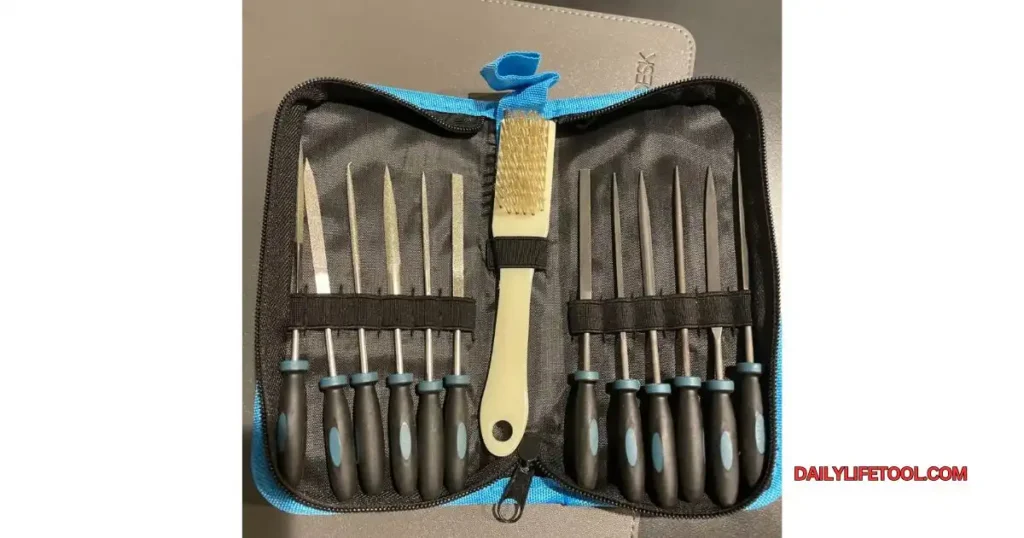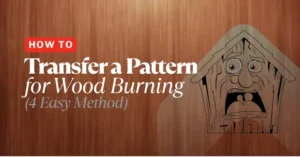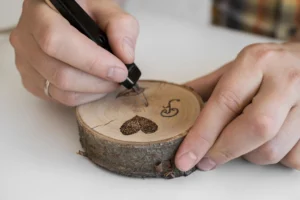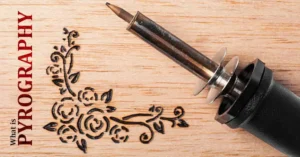How to Choose the Right Type of Wood Rasp?
To choose the right wood rasp, consider the task at hand. For larger areas and quicker wood removal, opt for a longer rasp. Its extended cutting surface allows for longer strokes, helping you remove more wood faster with each pass.
As I ran my fingers across the perfectly shaped guitar neck, I couldn’t help but smile.
After 15 years of crafting custom instruments, I’ve learned that the secret to achieving that smooth, perfect curve isn’t expensive machinery but selecting the right wood rasp.
According to a recent survey by Fine Woodworking Magazine, 73% of professional woodworkers cite improper rasp selection as the primary cause of surface finishing issues.
During my 15 years as a professional woodworker, I learned that skilled craftspeople are only as good as their tools.
When I started shaping guitar necks, I wasted $200 on the wrong wood rasp types before finding my perfect match.
Today, I’ll share everything I’ve discovered about How to Choose the Right Type of Wood Rasp.

Quick Answer: How to Choose the Right Type of Wood Rasp?
- Understand the Types: Choose from flat, half-round, or round rasps depending on the shape and detail of your project.
- Consider Tooth Patterns: Use coarse rasps for fast material removal and fine-tooth rasps for detailed finishing.
- Match the Rasp to the Wood: Opt for aggressive rasps for hardwoods and finer ones for softwoods to avoid damage.
- Evaluate Length and Width: Longer rasps cover more area; narrower ones are better for precision work.
- Check Handle Ergonomics: A comfortable handle enhances control and reduces fatigue during use.
For detailed insights, read the full article!
Table of Contents
Understanding Wood Rasps
What is a Wood Rasp?
A wood rasp is more than just a rough file. As a fundamental professional woodworking tool, it’s your primary instrument for removing material and creating smooth curves in wood.
My first experience with hand rasp tools taught me the difference between a good rasp and a great one, which can make or break your project.
Rasp vs. File: Key Differences
The main difference between a wood rasp and a file lies in their teeth.
Rasps have individual, pointed teeth designed for aggressive material removal, making them ideal for shaping wood.
Files, on the other hand, feature ridged teeth that are better suited for fine detailing and smoothing.
For example, when shaping the neck of a guitar, I start with a coarse rasp to establish the curve and switch to an acceptable file for smooth finishing.
Types of Wood Rasps in Modern Woodworking
Modern woodworking offers various rasps tailored to specific tasks:
- Flat wood rasps: Ideal for straight surfaces.
- Half-round rasps: Versatile for both flat and curved surfaces.
- Round wood rasps: Best for shaping deep hollows.
- Cabinet rasps: Perfect for detailed shaping work.
When shaping furniture legs, I rely heavily on a half-round rasp.
Its versatility lets me shape the outer contours and subtle curves without switching tools.
Essential Features of Wood Rasps
Length and Its Impact on Performance
Wood rasp sizes typically range from 6 to 12 inches.
I pick 10-inch rasps for most projects because they balance control and coverage. Shorter rasps work better for precision tasks, while longer ones remove material quickly.
Shape Variations and Their Uses
Shapes matter greatly in woodworking. For example:
- Flat rasps: Ideal for smoothing straight surfaces.
- Round rasps: Effective for carving hollows.
- Half-round rasps: Great all-rounders for curved edges and flat areas.
Wood Rasp Width Considerations
Rasp width affects control and efficiency. Wider rasps cover more surface area, making them suitable for large projects like furniture shaping.
Narrower rasps, such as luthiery or intricate carvings, are better for precision work.
In my experience, a ¾-inch wide rasp balances most tasks, giving enough coverage without sacrificing precision.
Wood Rasp Cross-Section Profiles
Cross-section profiles in rasps impact their performance significantly:
- Flat rasps are best for straight surfaces and edges.
- Half-round rasps handle curved surfaces and tighter angles effectively.
- Round rasps are ideal for creating hollows or refining intricate details.
When shaping furniture legs, I rely heavily on a half-round rasp.
Its versatility lets me shape the outer contours and subtle curves without switching tools.
Wood Rasp: Cut Aggressiveness Levels
The cut level of a rasp determines its material removal speed.
- Bastard cut rasps: Rough shaping.
- Fine-cut rasps: Finishing work.
- Medium cuts: Versatile for general applications.
Machine-Cut vs. Hand-Cut Teet
Machine-cut rasps offer uniform teeth for predictable results, while hand-cut rasps feature irregular tooth patterns that reduce scratching and create a smoother finish.
For beginners, machine-cut rasps provide consistency.
However, for advanced projects like instrument-making, hand-cut rasps are indispensable.
They give me greater control over the final texture of the wood.
Handle Types and Ergonomics
Handle comfort is crucial for extended use. I recommend ergonomic wooden handles as they provide a firm grip and reduce hand fatigue during long sessions.
Choosing the Right Rasp for Different Projects
Furniture Making
For furniture, a coarse cabinet rasp is excellent for initial shaping, while finer rasps refine the surface before sanding.
Guitar Building and Lutherie
As a luthier, I rely on fine wood carving rasps for precision work on guitar necks and bodies. The Rasp’s tooth pattern is critical in achieving a smooth finish without tear-out.
General Woodworking
Medium-cut professional wood rasps are versatile for most general woodworking projects, from basic shaping to detailing.
Sculpture and Artistic Work
For artistic carving, round and half-round rasps with varying cuts provide flexibility and control when working on intricate designs.
Restoration Projects
Restoration work often requires delicate handling. Fine-cut rasps are ideal for refurbishing antique furniture or sculptures.
Top Wood Rasps in the Market
Budget-Friendly Options
For beginners, the Nicholson Bastard Cut Rasp is a great entry-level tool for learning proper techniques without a hefty investment.
Mid-Range Choices
The Nicholson Cabinet Maker’s Rasp offers a balance of performance and affordability, suitable for hobbyists and semi-professionals.
Premium and Professional Rasps
The Stemac Dragon Hand Cut Rasp delivers unmatched precision and durability for seasoned woodworkers.
Detailed Product Reviews
- Shinto Saw Rasp: A unique tool featuring double-sided teeth for coarse and satisfactory work.
- Nicholson Combination Rasp/File: Combines the best of both worlds for versatility.
Wood Types and Rasp Selection
Hardwoods vs. Softwoods
Working with hardwoods like oak or maple requires rasps with aggressive teeth for efficient material removal.
However, softwoods like cedar or pine benefit from finer tooth patterns to avoid tear-out.
I remember struggling with pine early on because I used a coarse rasp that tore up the grain.
Switching to a fine-tooth rasp made all the difference in achieving a clean finish.
Grain Direction Considerations
Always work at a 45-degree angle to the grain to avoid gouges and achieve a smoother finish.
Moisture Content Effects
Wood with high moisture content clogs rasps quickly. Dry wood, while harder to shape, yields cleaner results. Always check the wood’s moisture level before starting.
When shaping green wood, I clean my Rasp frequently to prevent buildup and maintain performance.
Wood Rasp: Practical Application Guide
Proper Rasp Techniques
- Start with coarser rasps and progress to finer cuts.
- Use long, consistent strokes.
- Apply light pressure to maintain control.
Common Mistakes to Avoid
- Using the wrong Rasp for the task.
- Ignoring grain direction leads to tear-out.
- Over-applying pressure damages the wood and tool.
Safety Guidelines and Best Practices
- Wear gloves to protect your hands.
- Secure your workpiece firmly.
- Maintain proper posture to avoid strain.
Working Around Curves and Corners
Use half-round rasps for edges and round rasps for tight curves. Practice gentle, sweeping motions to avoid over-shaping.
Achieving Different Finishes
For a polished look, transition to fine rasps before sanding. This ensures a smoother surface and reduces sanding time.
Wood Rasp Maintenance and Care
Cleaning Methods
I clean my rasps weekly using a brass brush to remove debris and apply mineral oil to prevent rust.
Storage Requirements
Store rasps in a dry, protective case to avoid damage and maintain their sharpness.
Sharpening Techniques
While most rasps aren’t sharpenable, maintaining their teeth with careful cleaning ensures longevity.
Extending Rasp Life
Inspect rasps regularly for wear or damage and replace them when performance declines.
Wood Rasp Troubleshooting Common Issues
Dealing with Clogging
Clogging is a common issue, especially with softer woods. Regular cleaning with a file card or brass brush helps maintain efficiency.
I lightly coat the Rasp with mineral oil before starting for stubborn clogs. This trick has worked wonders for me, especially during long projects.
Preventing Surface Damage
Maintain consistent pressure and work with the grain to avoid gouges.
Handling Tough Spots
Alternate between coarse and fine rasps to gradually shape the material for difficult areas.
Fixing Uneven Surfaces
Ensure steady, even strokes, and check your progress frequently.
Wood Rasp Professional Tips and Tricks
- Use a combination of rasps and files for versatile results.
- Practice on scrap wood to master techniques before tackling projects.
- Keep multiple rasps on hand for different tasks.
Wood Rasp Advanced Techniques for Precision
For intricate projects, such as carvings or luthiery:
- Use smaller rasps with fine teeth.
- Combine rasps with sanding blocks for smoother transitions.
- Practice layering rasp cuts for gradual shaping.
I once used these techniques to carve a detailed leaf pattern on a wooden box lid. The result was a smooth, professional-grade finish.
How to Choose the Right Type of Wood Rasp: Buying Guide
Price Range Considerations
Quality rasps are an investment. Budget-friendly options suffice for beginners, while professionals should prioritize durability and performance.
Where to Buy Quality Rasps
Reputable hardware stores and online retailers like Amazon offer a wide selection of wood rasps.
What to Look for When Purchasing
Consider handle ergonomics, tooth pattern, and material quality. Read reviews to ensure reliability.
Value vs. Investment Analysis
While premium rasps are pricier, their longevity and performance often justify the cost.
Final Thoughts and Recommendations
After years of testing various tools and teaching countless students, I’ve found that selecting the right Rasp comes down to three factors:
- Project requirements
- Wood type
- Personal preference
Remember, a quality rasp is an investment in your craft.
Whether you’re building furniture, shaping instruments, or working on general woodworking projects, the right Rasp will become an extension of your hands.
What’s your experience with wood rasps?
Have you found your perfect match, or are you still searching?
Share your thoughts in the comments below. I’d love to hear about your woodworking journey.
Looking to upgrade your woodworking skills?
Stay tuned for my upcoming series on advanced shaping techniques. In it, I’ll explore the art of wood manipulation and show you how to achieve professional-grade results with your rasps.
FAQs: How to Choose the Right Type of Wood Rasp
What are the different types of rasps?
The main types are flat, half-round, round, and cabinet rasps. Each comes in different cuts (coarse, medium, fine) for various woodworking needs.
What is the difference between round and flat rasps?
Flat rasps are for straight surfaces and outer curves, while round rasps are for shaping interior curves and hollows.
What is the difference between a wood rasp and a file?
Wood rasps have individual pointed teeth for aggressive wood removal, while files have continuous ridges better suited for metal and fine finishing.
What file is best for wood?
A cabinet rasp is best for general woodworking. For finishing, use a fine-cut wood file or cabinet file.
How to properly use a rasp?
Hold at a 45-degree angle, apply light pressure, work with the grain when possible, and use long, steady strokes. Clean the rasp regularly to prevent clogging.
Related Article:







